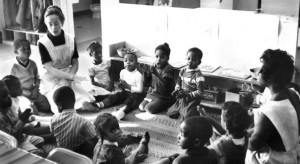When it comes to reading to children—parents can’t start too early! Children develop better language skills when they’re read to and have a jump start on developing literacy skills they will need once they enter school. Yet every year, more than 1 in 3 students entering American schools do not have the language skills they need to master reading.
To help close that gap, in 2014 the American Academy of Pediatrics issued a policy statement, calling for all pediatricians, nationwide, to discuss with parents the importance of reading to their children. In addition, the policy calls for doctors to provide books to low income and at-risk families, to help encourage reading in the home.
You can read the full policy statement here: http://tinyurl.com/hrjq7g5
For years, researchers have known that children who are read to have a larger vocabulary and better early language skills than children who are not read to.
Research has shown that up to 98% of the words children know by the age of three come from the words their parents or caregivers use in the home.
Now, a new study from the University of Iowa has found that babies in their first year display more speech-like sounds while they’re being read to versus other forms of play like puppets or toys. Researchers believe this is because caregivers tend to help babies along with words as they are reading to them—even if the vocalizations are not directly tied to the text being read.
For instance, a baby might say, ‘ba, ba,’ and the caregiver might mimic and then expand on the sound to say the word, ‘ball.’ In this way, researchers believe, babies can be helped to grow their awareness of words and thus, their vocabularies. The study appears in the January 2016 issue of Language, Learning and Development. To read the full study, click here: http://tinyurl.com/ho7e4pq
The University of Iowa study builds on earlier research into early childhood development and language acquisition. In 1992, a landmark study conducted by two researchers from the University of Kansas found that by the age of 3, children from lower-income households can have a 30 million word gap behind children from upper and middle class homes where reading to children can be more common.
Drs. Betty Hart and Todd Risley spent two and a half years with families from low, middle and upper income brackets and observed children in those homes from seven months to three years of age.
“Simply in words heard, the average child on welfare was having half as much experience per hour (616 words per hour) as the average working-class child (1,251 words per hour) and less than one-third that of the average child in a professional family (2,153 words per hour),” the researchers wrote.
To read more about the findings of Drs. Hart and Risley, check out their 1995 book, “Meaningful Differences in the Everyday Experience of Young American Children.” Available from Amazon, here: http://tinyurl.com/joosz3y
What was the key link to children developing expanded vocabularies and having better language skills in both the recent University of Iowa study and the work of Drs. Hart and Risley at the University of Kansas? Caregiver interaction.
Research has shown that up to 98% of the words children know by the age of three come from the words their parents or caregivers use in the home.
There are resources available to families to help close this gap. Start by talking to your pediatrician.
If you live in the Chicagoland area, check out the Thirty Million Words initiative founded by Dr. Dana Suskind at the University of Chicago. TMW works with parents in the city and suburbs by offering home visits and special events dedicated to providing literacy support to families. To learn more, check out TMW’s web site, here: http://thirtymillionwords.org
If you don’t live in Chicago, you can still read about TMW’s work in Dr. Suskind’s new book, published in September 2015: “Thirty Million Words: Building a Child’s Brain.” Available from Amazon: http://tinyurl.com/hqj6xxh

